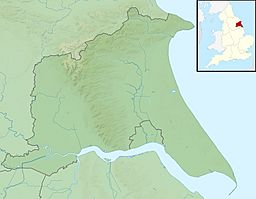Hornsea Mere facts for kids
Quick facts for kids Hornsea Mere |
|
|---|---|

Swan Island, Hornsea Mere
|
|
| Location | Yorkshire |
| Coordinates | 53°54′20″N 0°11′10″W / 53.90556°N 0.18611°W |
| Basin countries | United Kingdom |
| Max. length | 2 miles (3.2 km) |
| Max. width | 0.75 miles (1.2 km) |
| Surface area | 467 acres (1.89 km2) |
| Max. depth | 12 feet (3.7 m) |
| Surface elevation | 26 feet (8 m) |
Hornsea Mere is the biggest freshwater lake in Yorkshire, England. It's located west of the town of Hornsea in the East Riding of Yorkshire. This lake was once a base for planes during the First World War, first for the Royal Naval Air Service and later for the Royal Air Force.
Contents
About Hornsea Mere
Hornsea Mere covers an area of about 467 acres (1.89 km2). It is 2 miles (3.2 km) long and 0.75 miles (1.2 km) wide at its broadest point. The deepest part of the lake is 12 feet (3.7 m).
The lake's average depth is about 4 feet 11 inches (1.5 m). Hornsea Mere sits only 26 feet (8 m) above sea level. Several small streams feed into the mere. A special gate at the eastern end controls the water flowing out. This water travels only 0.68 miles (1.1 km) east before reaching the North Sea.
Fun Activities at the Mere
Hornsea Mere is a great spot for bird-watching. It's also a popular tourist attraction where you can enjoy many activities. Visitors can go rowing, sailing, or take boat trips. It's also a good place for fishing.
Wildlife and Nature
The mere is a very important natural area. It is known as a Site of Special Scientific Interest and a Special Protection Area for birds. Many different bird species live here all year round. It's especially important for a group of gadwall ducks that migrate there. Because the lake is quite shallow, it has many different kinds of swamp and fen plants.
Hornsea Mere was even shown on the BBC television show Seven Natural Wonders.
Who Owns the Mere?
The lake is owned by Wassand Hall, which is a large estate located to the west of the mere. The estate bought the mere for a small amount of money, just £50, way back in the 1500s.
The mere is also the home base for the Hornsea Sailing Club.
Hornsea Mere During World War I
A special base for seaplanes was opened on Hornsea Mere in September 1917. This base belonged to the Royal Naval Air Service (RNAS). At first, two squadrons, numbers 248 and 251, operated from here. Their main office was in Killingholme. However, No. 251 Squadron used planes that couldn't land on water. So, even though they were based there, they didn't actually fly from Hornsea Mere.
The Seaplane Base Setup
The RNAS base was built on a small piece of land called Kirkholme Nab. This is a 6-acre (2.4 ha) peninsula that reaches out from the eastern shore. The RNAS built two large hangars, called Bessonneau hangars, and two slipways. These slipways allowed about a dozen seaplanes to take off and land from the base.
Planes from this base flew many missions. They helped protect the coast and attacked enemy submarines. These different flights were later combined to form No. 248 Squadron. This squadron was part of No. 79 (Operations) Wing, which also managed No. 251 Squadron. This explains why both squadrons were linked to Hornsea Mere.
After the War
When the Royal Air Force (RAF) left the base in 1919, they left behind several brick buildings. These buildings are still used today by the boatyard and a cafe. Even after the RAF moved out, the mere and its old buildings were used. They became a starting point for planes practicing bombing runs. These practice runs took place at a bombing range called RAF Cowden on the East Yorkshire coast.


